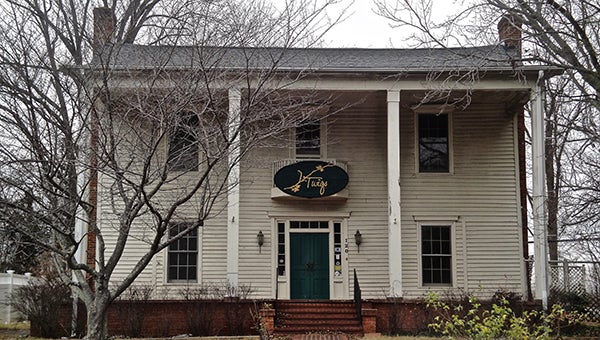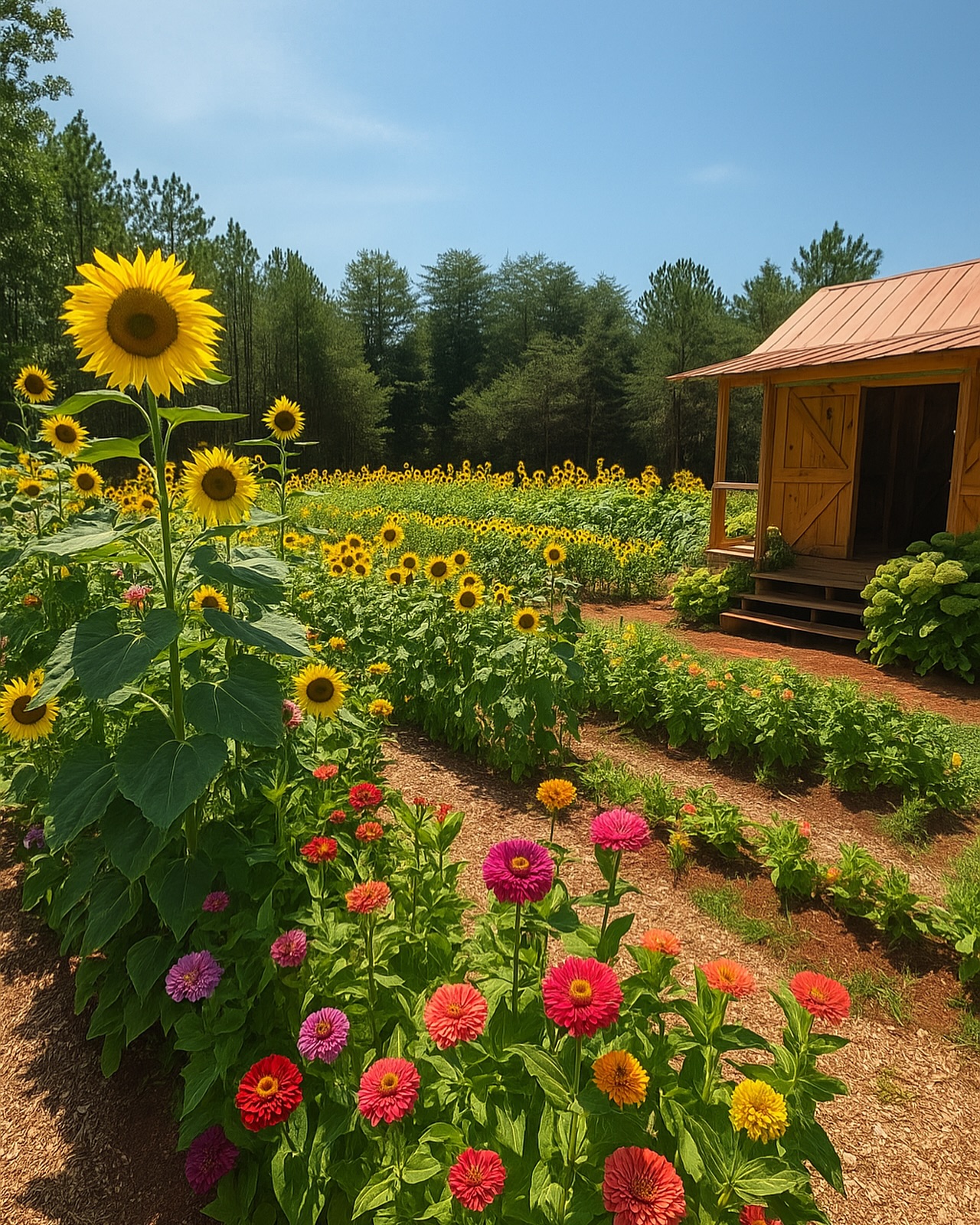The mystery of the white house
Published 10:00 pm Monday, January 9, 2017

At around 160 years old, this stately structure overlooking Landrum’s
train tracks has an interesting history. (Photos by Linda List)
Have you ever wondered about the history of the large white house on Trade St. in Landrum? Until a few years back it was a restaurant called Twigs. Now closed, a for sale sign rests on the rickety picket fence in front of the property. It seems a bit incongruous in its location of shops, restaurant, and funeral home. There it sits, a grand old building, proudly looking over the railroad tracks to the smoky Blue Ridge Mountains. I decide it’s time to do a little research. I want to know more.
I start by calling the realtor, Bill Terry, whose name is on the for sale sign. From Bill, I learn that the house was built, according to Spartanburg County assessor records, around 1857. That makes it antebellum, and now I’m hooked. The house has stood on this knoll before Landrum even existed. Who lived here, I wonder? What stories are hidden in its walls?
Bill fills me in on some of the updating that has been done to the building including new plumbing, wiring, recently reshingled roof, all the things a potential buyer would need to know. He relates that it was once the Petty Funeral Home, then a bed and breakfast named The Country Mouse, followed by Twigs restaurant. He has agreed to give me a tour of the house.
Trending
I first notice the beautiful pine floors and high, bead board ceilings. They appear to be original. The house has seven fireplaces, which would have been the heat source for the original inhabitants. The fireplaces are small and not deep. From other historic homes that I’ve toured, I know that a shallow fireplace was able to give more heat into the room instead of losing it up the chimney. The wooden mantles that surround each fireplace appear to be hand carved, as the cuts aren’t always even. Although quite primitive, each mantle is of a different design. I would surmise they are original.
Two of the downstairs rooms can be separated by large pocket doors. Since they are made to slide into the walls, they are probably original. I can picture the rooms being opened up for a celebration, maybe a wedding, or a sad event such as a funeral, and then closed off when smaller rooms were used, keeping in the warmth from the fireplaces.
A large staircase leads to the upstairs bedrooms. A door at the front end of the upstairs hall opens onto a small balcony. From this vantage point, a hazy outline of the mountains comes into view. I don’t know if this feature would have been incorporated in the original house, but it seems unlikely that it would have been added at a later date.
We return downstairs to the front of the house and step outside onto the wide porch that sits under the tall columns. Bill tells me this area is an addition. The original house did not have the roof overhang or the columns. If there was a porch, it probably would have been wood and no longer exists. The heavy, solid doors catch
my eye as they appear to be original. The antique doorknob hardware was made with an interesting, intricate design. We walk around to the side of the house and notice the old bricks and stones that form the base of the chimney.
I thank Bill for the tour and for providing me with the facts that he knows. He suggests a book, “The Who and Why of Landrum, S.C. 29356” by James Walton Lawrence, Sr., and I head to the Spartanburg Library to do some research. Who built this lovely old home? Was it originally a large farm? Landrum didn’t exist in 1857 so how did it come to be here?
Trending
I perused several reference books containing history of this area, before and after Landrum became a town, but any mention of this dwelling eluded me. I decide to consult Dean Campbell, the local historian of this area.
He responds with a description of the melee and murder that took place June 12, 1877, the day the Landrum Depot opened. From Dean Campbell, “Landrum’s Station depot had been built on the rail line, and a giant barbecue was held to welcome Spartanburg, Greenville and Polk County residents to see the giant locomotive. An auction to sell sub-divided lots along both sides of the railroad (the beginning of the town of Landrum) was also part of the festivities. The only structures at the site besides the depot was a farmhouse and outbuildings, including a corn crib.” He concurs, “This would have to be the building you refer to as having been built in the 1857-59 era. No mention of the farmhouse owner was ever made in accounts of the event.”
Dean continues with a description of the murder of Deputy Marshall J.S. Ledford, one of some 50 notables, present for the festivities. “A number of both licensed and unlicensed distillers, who disliked Ledford’s dogged pursuit of tax payments or tax liens to the fullest extent, were present. They had spread word that Marshall Ledford would be a dead man the next time they saw him. Shots were heard but Ledford was not hit by any of them. Instead, in a scuffle, he fell off the flat car on the depot side and was stabbed in the back.” Ledford died on the train headed back to Spartanburg. “So,” Dean concludes, “your historic building was witness to the tragic beginning of the town of Landrum. Sorry I don’t know who built it.”
In the “Who and Why of Landrum,” I discover a passage described as ‘Testimony Taken Before The Coroner’s Jury.’ On June 14, a W.D. Swain swore in a statement,
“I was at home in Landrum on June 12 and saw part of the affray that occurred that day.” Could W.D. Swain possibly have been a resident in “my white house”? When he said he was at home, did he mean that he was in his home, and since Dean Campbell described the house as the only structure beside the depot, can I conclude that this could have been his home?
In a little more research I discover that W.D. Swain is buried at N Pacolet Cemetery, near Fingerville and Rainbow Lake, with his wife, Susan. Two other Swains are buried in close proximity, Hattie born 1857 and John born 1858. If these are his children, the birth dates would mesh with the house being built in 1857.
The only other mention of the structure is in the “Who and Why of Landrum” relating the history of the Petty Funeral Home. The author explains that “after World War II, Tolley Petty moved the business to Landrum, locating in a stately old residence on Trade Avenue.” This would confirm that the house was a residence up until that time.
And so the mystery continues. Who did build this once majestic home? What is the full history of this house? Could it be listed in the National Register of Historic Places? If you have any information to share, please email me at lin17th@aol.com.
A Sad Footnote
If you follow my column “Landrum Wanderings,” you will remember the columns
I wrote on the Foster family and D.M. Wolfe. I’m sorry to report that D.M. passed away Nov. 21 at the age of 84. And he left this world in style! His casket was taken from the funeral home to the graveside in a horse drawn, white carriage, the driver outfitted in a black stovepipe hat. Family and friends followed, walking along behind the carriage. D.M. was buried with his favorite white cowboy hat that he wore in the photos that accompanied my stories. Good-bye D.M. It was a treasure to visit with you and an honor to chronicle your life.





